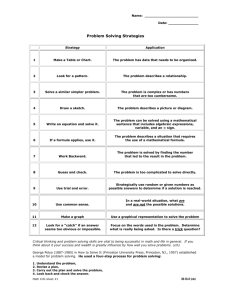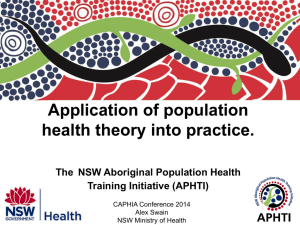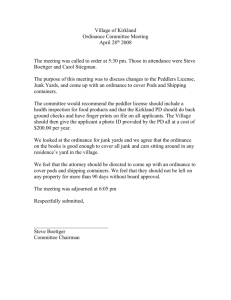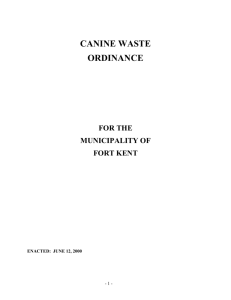Word - Australian Human Rights Commission
advertisement
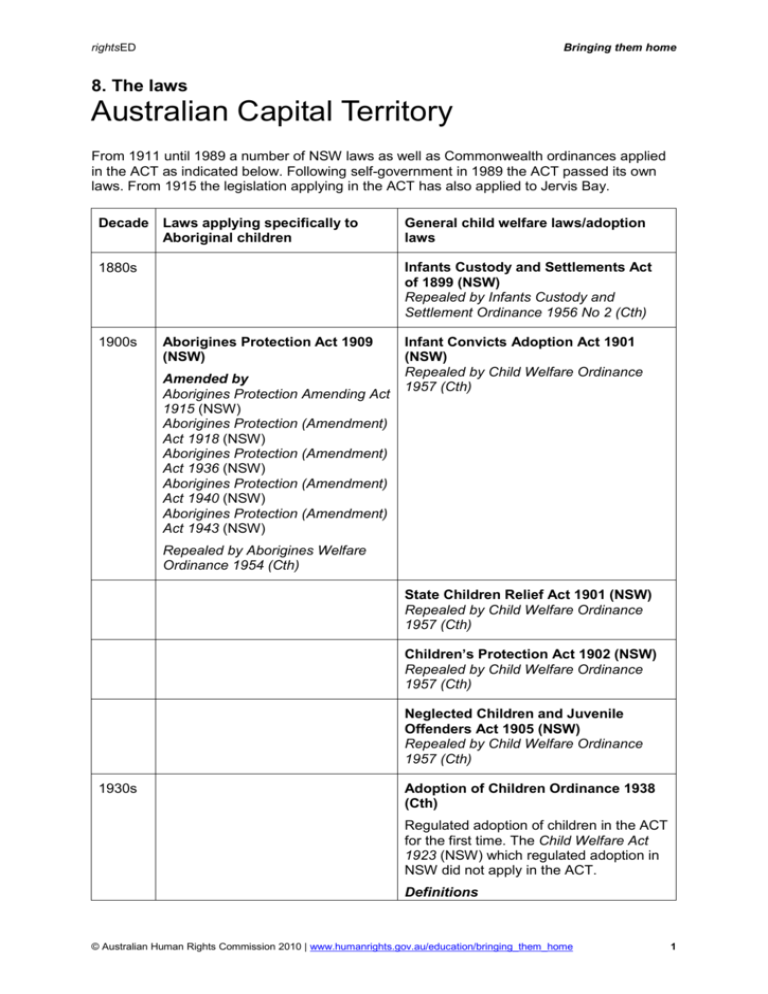
rightsED Bringing them home 8. The laws Australian Capital Territory From 1911 until 1989 a number of NSW laws as well as Commonwealth ordinances applied in the ACT as indicated below. Following self-government in 1989 the ACT passed its own laws. From 1915 the legislation applying in the ACT has also applied to Jervis Bay. Decade Laws applying specifically to Aboriginal children General child welfare laws/adoption laws 1880s Infants Custody and Settlements Act of 1899 (NSW) Repealed by Infants Custody and Settlement Ordinance 1956 No 2 (Cth) 1900s Aborigines Protection Act 1909 (NSW) Amended by Aborigines Protection Amending Act 1915 (NSW) Aborigines Protection (Amendment) Act 1918 (NSW) Aborigines Protection (Amendment) Act 1936 (NSW) Aborigines Protection (Amendment) Act 1940 (NSW) Aborigines Protection (Amendment) Act 1943 (NSW) Infant Convicts Adoption Act 1901 (NSW) Repealed by Child Welfare Ordinance 1957 (Cth) Repealed by Aborigines Welfare Ordinance 1954 (Cth) State Children Relief Act 1901 (NSW) Repealed by Child Welfare Ordinance 1957 (Cth) Children’s Protection Act 1902 (NSW) Repealed by Child Welfare Ordinance 1957 (Cth) Neglected Children and Juvenile Offenders Act 1905 (NSW) Repealed by Child Welfare Ordinance 1957 (Cth) 1930s Adoption of Children Ordinance 1938 (Cth) Regulated adoption of children in the ACT for the first time. The Child Welfare Act 1923 (NSW) which regulated adoption in NSW did not apply in the ACT. Definitions © Australian Human Rights Commission 2010 | www.humanrights.gov.au/education/bringing_them_home 1 rightsED Bringing them home Decade Laws applying specifically to Aboriginal children General child welfare laws/adoption laws infant – a person under 21 Key provisions Consent to adoption required of parent or guardian, person with custody, or person liable to contribute to support. Consent may be dispensed with where a person has abandoned or deserted the infant; cannot be found; is incapable of giving consent; persistently neglected or refused to contribute to support of infant where liable; or where the court is satisfied that in all the circumstances it should be dispensed with.Repealed by Adoption of Children Ordinance 1965 (Cth) Child Welfare Agreement Ordinance 1941 (Cth) Definitions child – a person under 18 Key provisions To approve an agreement made between Commonwealth and NSW for the reception, detention and maintenance in institutions in NSW of children committed to those institutions by courts of the ACT. When an ACT court commits a child to a state institution, the child may be taken by an ACT officer to a shelter in Sydney. The child then comes under the provisions of the Child Welfare Act 1939 (NSW) as if the child had been committed to a NSW institution by a NSW children’s court. The agreement was varied by the Child Welfare Agreement Ordinance 1962. Repealed by Children’s Services Ordinance 1986 (Cth) Juvenile Offenders Ordinance 1941 Key provisions An ACT court may commit a child under the Neglected Children and Juvenile Offenders Act 1905 (NSW) to a NSW institution. Repealed by Child Welfare Ordinance 1957 (Cth) 1940s – Aborigines Welfare Ordinance 1954 (Cth) 1950s Definitions aboriginal – a person who is a ‘full blooded’ or ‘half-caste’ ‘aboriginal Neglected Children and Juvenile Offenders Ordinance 1949 (Cth) Amended the definition of ‘neglected child’ in the Neglected Children and Juvenile Offenders Act 1905 (NSW). © Australian Human Rights Commission 2010 | www.humanrights.gov.au/education/bringing_them_home 2 rightsED Bringing them home Decade Laws applying specifically to Aboriginal children native of Australia’ and who is temporarily or permanently in the Territory General child welfare laws/adoption laws Repealed by Child Welfare Ordinance 1957 (Cth) child – an ‘aboriginal’ under the age of 18 Key provisions The Minister may exercise a general supervision and care over all ‘aborigines’ and over all matters affecting the interests and welfare of ‘aborigines’. On the application of a parent or guardian of a child, the Minister may admit the child to their control and provide for his/her maintenance, education and training. A person who in the opinion of the Minister is guilty of misconduct may be removed from a reserve. The Minister may apply to a court for an order to remove an ‘aboriginal person’ or a person ‘apparently having an admixture of ‘aboriginal blood’ to a reserve or such other place as the court directs on the ground that the person ‘is living in insanitary or undesirable conditions’ or ‘should be placed under control’. The court may also direct that the person returns to the State or other place from which he/she came. The Minister may issue exemptions from ordinance. Repealed by Aborigines Welfare Repeal Ordinance 1965 (Cth) After the Aborigines Welfare Repeal Ordinance 1965 the removal of all Aboriginal children came under the Child Welfare Ordinance 1957 and subsequent child welfare legislation. 1950s Child Welfare Ordinance 1957 Ended the application of NSW child welfare legislation to the ACT. Definitions admit to government control – admit to control of Minister for purpose of being apprenticed, boarded out, placed out or placed as an adopted boarder and admitted to government control board out – place in care of person for purpose of being nursed, maintained, trained or educated by that person or in that persons home child – a person under 16 young person – a person under 18 © Australian Human Rights Commission 2010 | www.humanrights.gov.au/education/bringing_them_home 3 rightsED Bringing them home neglected child – a child who ‘wanders about with reputed thieves or persons who have no visible lawful means of support’; has ‘no visible lawful means of support or no fixed place of abode’; ‘habitually wanders about in a public place with no ostensible occupation or habitually sleeps in the open air in a public place’; ‘without reasonable excuse not provided with sufficient or proper food, nursing, clothing, medical aid or lodging or who is ill treated or exposed’; ‘whose parents are drunkards’; is ‘living in conditions that indicate lapsing or likely to lapse into a life of vice or crime’; is ‘under incompetent or improper guardianship’; is ‘destitute’; whose parents are ‘unfit to retain the child in their care’; who is ‘falling into bad associations or exposed to moral danger’; or who without lawful excuse does not attend school regularly ward – includes a child ‘admitted to government control’, committed to an institution or admitted to a hostel Key provisions Where a court commits a child or young person to the care of the Minister on the ground that the child is neglected, or a parent has consented to the admission of a child or young person to government control, the child may be apprenticed, boarded out, placed out or placed as an adopted boarder. The court may also commit a neglected child to an institution. If a child committed to an institution may be removed to NSW for detention and maintenance in a State institution. The Minister is the guardian of wards. Amended by Child Welfare Amendment Ordinance 1979 (Cth) – removed powers of Minister to place a ward as an adopted boarder or apprentice. Minister to provide accommodation and maintenance for child admitted to government control. Minister may revoke an admission to government control on the application of a relative. Repealed by Children’s Services Ordinance 1986 (Cth) Infants Custody and Settlement Ordinance 1956 No. 2 (Cth) Repealed Infants Custody and Settlements Act of 1899 (NSW). A court may, upon the application of a parent, make such order as it thinks fit regarding the custody of the infant. Where the court is of the opinion that a parent has abandoned, neglected or deserted an infant; so conducted himself/herself that custody should be refused; or the tender age of the infant of his/her state of health render it expedient he/she should remain with his/her mother or some other person then court may decline application for custody. Where a parent has abandoned, deserted or neglected an infant, the parent must satisfy the court that he/she is a fit person to have custody. Where the court is satisfied that a person with custody is unfit to continue because of cruelty or neglect, court may order the infant be given up to the custody of another. Repealed by Infants Custody and Settlements (Repeal) Act 1995 (ACT) 1960s Adoption of Children Ordinance 1965 (Cth) Definitions child – person under 21 Key provisions The welfare and interests of the child are the paramount consideration. Repealed by Adoption Act 1993 (ACT) 1980s Children’s Services Ordinance 1986 (Cth) Replaced Child Welfare Ordinance 1957 (Cth). © Australian Human Rights Commission 2010 | www.humanrights.gov.au/education/bringing_them_home 4 rightsED Bringing them home Definitions child – person under 18 in need of care – includes a child who has been or is likely to be physically injured or sexually abused; the living circumstances of the child have impaired or are likely to impair the child’s health or lead to psychological damage; the child is engaging in behaviour likely to be harmful; there no appropriate person to care for child; the child has been abandoned; there is a serious incompatibility between the child and his/her parents or guardian; or the child not attending school and this is likely to be harmful. Key provisions Emphasises strengthening and preserving the relationship between the child and his/her family and the desirability of leaving child in his or her home. Where a court finds that a child is in need of care it may make a supervision order; a residential order; commit the child to an institution; make the child a ward of the Director of Family Services; or refer the child to the Mental Health Tribunal for assessment. 1990s Adoption Act 1993 (ACT) An adoption order must be in accordance with the Aboriginal Child Placement Principle. © Australian Human Rights Commission 2010 | www.humanrights.gov.au/education/bringing_them_home 5
